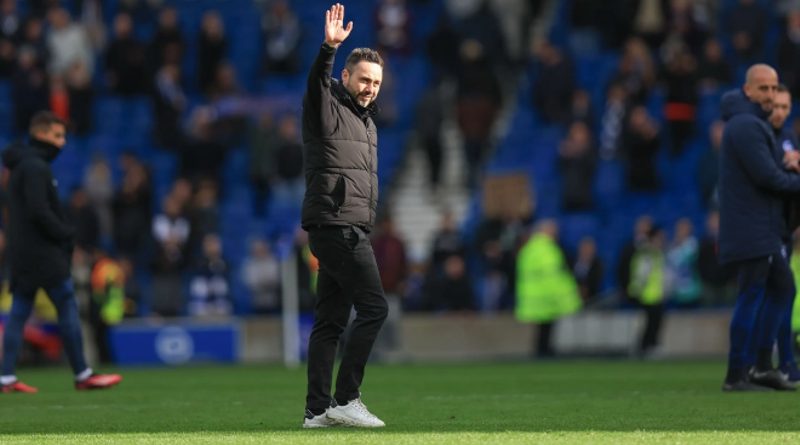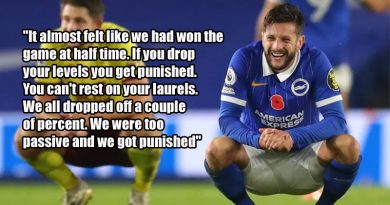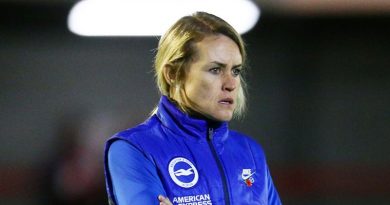The numbers behind an incredible 2023 for Brighton & Hove Albion
Where does 2023 rank as a calendar year in the history of Brighton & Hove Albion? Dive into the numbers and it becomes clear that no 12 months comes close to what the Seagulls have achieved in the Premier League under Roberto De Zerbi.
This does not come as total surprise. Back in June, WAB analysed the performance metrics of the 2022-23 season with the underlying statistics giving much confidence that Brighton could continue to go from strength to strength in 2023-24.
Sure enough, that has been backed up with the Albion’s continuing presence in the race for European qualification whilst having to cope with the sort of injury list even the biggest doom mongers would not have predicted.
Brighton finished sixth in the Premier League 2023 calendar year table on 1.66 points per game. Manchester City unsurprisingly led the way on 2.27 points per game, followed by Aston Villa (2.02), Liverpool (1.98), Arsenal (1.93) and Manchester United (1.76).
Below the Albion in seventh were Newcastle United (1.65), Spurs (1.64), West Ham United (1.48) with Brentford (1.38) rounding off the top 10.
In 2022, Brighton were eighth with a points per game average of 1.42. Roberto De Zerbi has therefore instigated a 17 percent improvement over the past 12 months.
The strong domestic performance is complemented by the Albion topping the Europa League group of death and comes in spite of three significant challenges compared to 2022.
Through the 2022-23 season, Brighton made a unique net profit of £106 million in the transfer market through selling Yves Bissouma, Marc Cucurella, Neal Maupay and Leandro Trossard.
A further £91 million profit followed in the summer transfer window via Moises Caicedo, Alexis Mac Allister and Robert Sanchez.
In addition, Levi Colwill returned to Chelsea at the end of his loan spell. The number of first choice players leaving the Amex is unprecedented compared to virtually every other Premier League club.
As already noted, injury levels in 2023 were way above 2022. Part of this comes from the additional challenges of playing in the Europa League with reduced preparation time for Premier League matches.
De Zerbi has rotated his squad more than any other top flight manager so far in the 2023-24 season, even prioritising Europe over domestic football. It is commendable that Brighton continue to fare so well domestically, given this approach.
Beyond points-per-game, two hugely positive issues stand out from 2023. The most obvious is the number of goals scored playing DeZerbiBall.
The Albion average almost twice as many goals per game in the Premier League under De Zerbi (1.9) compared to Graham Potter (1.1) and Chris Hughton (0.9).

As highlighted by The Athletic, 2023 was only the second calendar year in Brighton history that over 100 goals have been scored. The Albion side of Billy Lane managed 115 goals in 1955 playing in Division Three South.
The other big positive comes from the impact of young players. 19 Brighton goals in 2023 were scored by teenagers, compared to 16 for the other 19 Premier League teams combined.
Brighton also top the table for minutes played by Under 21s so far in 2023-24 with more than 15 percent of playing time compared to a league average of just under five percent.
In terms of more niche statistics, a look at the numbers backs up Pep Guardiola’s assertion back in May about Brighton: “There’s no team better that make the process to bring the keeper, the ball, to the last quarter. There’s no team better in modern football right now.”
The tables below highlight the Seagulls’ position in a range of metrics. In every passing category, Brighton are behind only Manchester City.
Brighton have strong attacking metrics and even managed to hang on in the top five for fewest shots conceded despite going from May onwards without keeping a Premier League clean sheet.
On an individual basis, the usual names continue to impress. Pascal Gross creates chances, Kaoru Mitoma is a big threat with the ball and Lewis Dunk plays a leading role with blocks and passes.
The continued delivery of effective, exciting attacking football despite all the challenges of 2023 is undoubtedly down to De Zerbi and his coaching team – meaning the one clear risk is if he decided to leave.
How many managers in the world could have formulated and implemented a brand new way of their team playing in the space of a week, as De Zerbi was forced to with his wingless wonders?
Brighton went from being a team whose attacking threat came from quick, direct wingers to beating Spurs with no width. Not to mention the lack of defenders, which did not prove a problem in securing a first clean sheet in 25 matches away at West Ham.
The first thing to hope for in 2024 therefore is De Zerbi signing a new contract. Beyond that, there are four areas which offer potential for Brighton to improve further on their 2023 numbers.
Players coming back from injuries will provide a huge boost, as well as better trying to prevent future injuries from occurring. The speed with which Pervis Estupinan and Tariq Lamptey were ruled out again upon their returns was of concern.
Converting draws into wins against teams near the bottom would boost the Albion’s points total. A frustrated De Zerbi talked about this after the 1-1 draw with Burnley, saying: “I don’t think there is anyone more than me who believes in my players, but we are a very good team, we are not a top team yet.”
“A top team wins today, would have won against Sheffield United, won with Fulham. Winning the three games we would be at third place in the table.”
“We deserve to win these three games, then why didn’t we? Maybe it is because we are not a top team yet. Maybe because the coach of Brighton is not a top coach yet.”
There remains a weakness both in scoring and conceding goals from set pieces which needs to be worked on, along with a general tightening up defensively.
Doubts persist about De Zerbi’s policy of rotating his goalkeepers. Jason Steele and Bart Verbruggen have conceded a combined five more goals than expected in the Premier League so far this season.
Encouragement in that department comes from Europa League performances, with no goals conceded in the last 430 minutes going back to the 2-2 draw away against Marseille in October.
Looking long-term, Verbruggen and Burnley’s James Trafford are the only 21-year-old goalkeeping regulars in the Premier League – a full three years younger than any other top flight number ones.
There is every reason to expect Verbruggen to live up to his world class potential, a glimpse of which comes from him having the top save percentage in the Europa League.
Second behind Verbruggen in that metric is another Brighton goalkeeper, Kjell Scherpen currently on loan at Sturm Graz.
Scherpen, Carl Rushworth and James Beadle are all impressing elsewhere and have all recently signed long term contracts, giving the Albion serious strength in the goalkeeping department.
The most significant area Brighton have looked a little lacking in the second half of 2023 is a defensive shield.
It is no surprise the Albion miss the contribution of Caicedo, who was in the top five Premier League players for interceptions, successful tackles and counter pressing in 2022-23.
In time, Carlos Baleba looks to have the capability to take over from Caicedo in that role once he has adapted to English football.
Peter Finn




